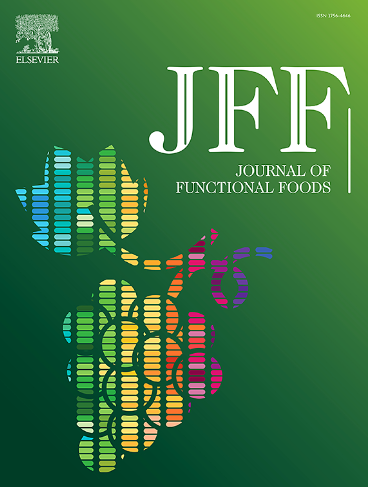魔芋低聚葡甘聚糖通过靶向微生物群-SCFAs-脑轴改善Aβ1-42诱导的阿尔茨海默病小鼠的认知障碍
IF 3.8
2区 农林科学
Q2 FOOD SCIENCE & TECHNOLOGY
引用次数: 0
摘要
本文研究了魔芋葡甘聚糖(KGM)和低聚葡甘聚糖(KOGM)对改善Aβ诱导的阿尔茨海默病(AD)的作用。行为测试表明,KGM和KOGM都能显著提高AD小鼠的空间学习和记忆能力,其中KOGM的效果更好。生化检测显示,KOGM能抑制Aβ的积累和Tau蛋白的过度磷酸化,上调bdnf、trkb、pi3k和akt,下调gsk3β。元基因组测序表明,KOGM调节了微生物群的多样性和功能,尤其是属于Alistipes的细菌,从而促进了短链脂肪酸(SCFAs)的产生及其循环水平。肠道微生物群、SCFAs和AD生理指标之间的密切关系表明,KOGM可以激活BDNF/PI3K/GSK3β通路,通过提高SCFAs水平来改善AD。这项研究强调,KOGM 是一种潜在的益生元,可通过肠道-大脑轴来预防注意力缺失症的发展,是治疗注意力缺失症的一种新方法。本文章由计算机程序翻译,如有差异,请以英文原文为准。

Konjac oligo-glucomannan ameliorate cognition impairments of Aβ1-42 induced Alzheimer’s disease in mice by targeting microbiota-SCFAs-brain axis
Here, the effects of konjac glucomannan (KGM) and oligo-glucomannan (KOGM) on improving Aβ-induced Alzheimer’s disease (AD) was investigated. Behavioral test suggested that both KGM and KOGM could significantly increase the spatial learning and memory of AD mice, with the latter be more effective. Biochemical examinations revealed that KOGM inhibited the Aβ accumulation and hyperphosphorylation of Tau protein, upregulated bdnf, trkb, pi3k and akt, and downregulated gsk3β. Metagenomic sequencing indicated that KOGM regulated the diversity and function of microbiota, especially bacteria belonging to Alistipes, thus promoting the production of short chain fatty acids (SCFAs), as well as their cyclic levels. The strong relationships among gut microbiota, SCFAs and physiological index for AD suggested that KOGM could activated BDNF/PI3K/GSK3β pathway to ameliorate AD, by enhancing SCFAs levels. This study emphasized the KOGM as a potential prebiotic to prevent AD progression, through the gut-brain axis and constitutes a novel approach in AD treatment.
求助全文
通过发布文献求助,成功后即可免费获取论文全文。
去求助
来源期刊

Journal of Functional Foods
FOOD SCIENCE & TECHNOLOGY-
CiteScore
9.60
自引率
1.80%
发文量
428
审稿时长
76 days
期刊介绍:
Journal of Functional Foods continues with the same aims and scope, editorial team, submission system and rigorous peer review. We give authors the possibility to publish their top-quality papers in a well-established leading journal in the food and nutrition fields. The Journal will keep its rigorous criteria to screen high impact research addressing relevant scientific topics and performed by sound methodologies.
The Journal of Functional Foods aims to bring together the results of fundamental and applied research into healthy foods and biologically active food ingredients.
The Journal is centered in the specific area at the boundaries among food technology, nutrition and health welcoming papers having a good interdisciplinary approach. The Journal will cover the fields of plant bioactives; dietary fibre, probiotics; functional lipids; bioactive peptides; vitamins, minerals and botanicals and other dietary supplements. Nutritional and technological aspects related to the development of functional foods and beverages are of core interest to the journal. Experimental works dealing with food digestion, bioavailability of food bioactives and on the mechanisms by which foods and their components are able to modulate physiological parameters connected with disease prevention are of particular interest as well as those dealing with personalized nutrition and nutritional needs in pathological subjects.
 求助内容:
求助内容: 应助结果提醒方式:
应助结果提醒方式:


